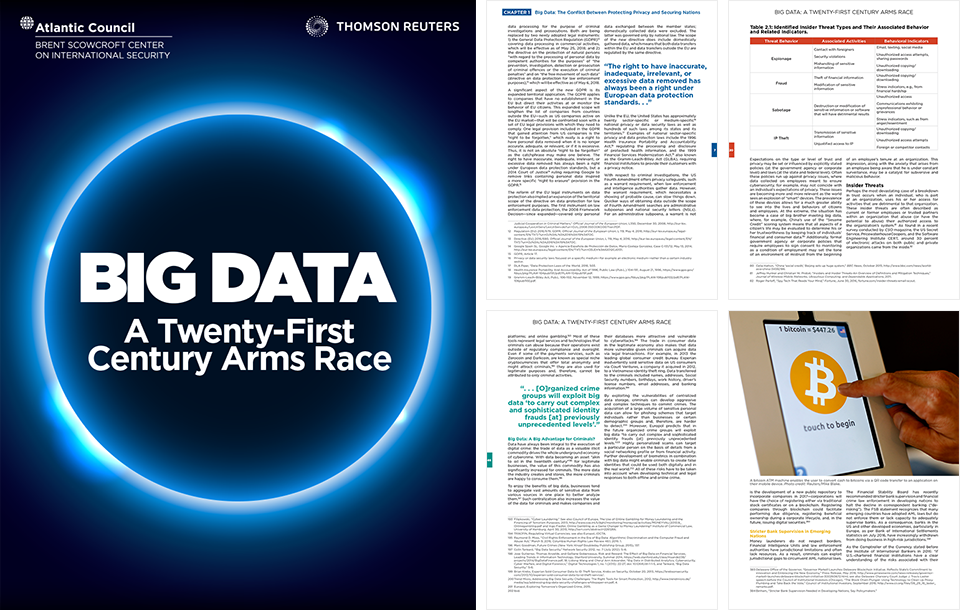This is all about supporting financial institutions as they onboard and monitor their customers. We provide them with the tools, analytics and insights that enable them to detect potential activities related to financial crime. The market is depending upon Thomson Reuters, and we’re investing heavily in this space.
This is all about supporting financial institutions as they onboard and monitor their customers. We provide them with the tools, analytics and insights that enable them to detect potential activities related to financial crime. The market is depending upon Thomson Reuters, and we’re investing heavily in this space.
It has been 120 years since the world’s introduction to a scientist who, consumed with power and more than a touch of greed, conducted experiments that led in short order from invisibility to criminal activity. The rich irony of H.G. Wells’ novel The Invisible Man is that, in the hands of a criminal, knowledge was used as a means to diminish vision; violence and mayhem ensued.
How prescient that has proven for today’s financial landscape, where bad actors of various stripes use sophisticated digital methods to cover their tracks, launder money and finance their nefarious activities.
An army of experts and technicians among Thomson Reuters global ranks is active in the fight against financial crime. Constantly in motion as an active thought leader and solutions provider, Thomson Reuters has identified several reasons that help contribute to the invisibility under which many of today’s financial criminals ply their trade with seeming impunity:
- A common public perception is that there are no real victims to financial crime, only faceless institutions.
- There is a mistaken belief that crimes committed or associated with financial activity have no link to violence or genuine harm against persons.
- Regulatory inconsistencies between nations in implementing anti-money laundering (AML) measures create loopholes for perpetrators.
- Lack of communication or coordination between various entities (law enforcement, financial institutions and regulators) can inhibit countermeasures.
- Institutions may not be utilizing available technology to defend themselves from attack or to identify criminals.
Consider This
Data released by Thomson Reuters World-Check® in 2017 shows:
Understanding that the first step in combating financial crime is to increase knowledge of how it takes root and what can be done to prevent it, Thomson Reuters is using its considerable expertise and industry relationships to help promote greater transparency and awareness. For instance, Thomson Reuters is a sponsoring supporter of the Future of Financial Intelligence Sharing (FFIS) program, an independent research partnership that produces content related to information-sharing mechanisms in the global fight against money laundering and financial crime. The FFIS advocates for the development of financial information-sharing partnerships (FISPs) among financial institutions (FIs), financial intelligence units, law enforcement agencies and regulators, to allow for a greater understanding of criminal threats extant in financial markets.
In a special report produced by the FFIS in 2017 with Thomson Reuters support, some very sobering statistics emerged to illustrate just how pervasive financial crime is in the digital age:
- It was forecast that over 2.6 million suspicious transaction activity reports were submitted by financial institutions in just the US and the UK alone.
- The annual growth rate in suspicious activity reporting across the UK, the US, Canada, Singapore, Hong Kong and Australia grew 11% year over year.
- Less than 10% of financial crime control leaders surveyed believed they had enough information to understand the most serious financial crimes in their jurisdictions.
- Less than 1% of criminal funds were frozen or confiscated.
Additionally in 2017, Thomson Reuters, in partnership with the Atlantic Council, issued a special report called Big Data: A Twenty-First Century Arms Race which contains chapters rich in information specific to tackling illicit financial flows and mitigating financial crime risk. According to the report, the key is leveraging big data and analytics as a toolkit to manage the trials posed by a fluid security landscape, and the report shares a host of big data analytic techniques, trends and recommendations.
During the same month as the publication of the big data special report, Thomson Reuters launched its Financial Crime Conversation initiative, consisting of various events to raise the level of discussion on financial crime’s impact and the efforts that can be taken to expose it.
The amount of data in the world is proliferating at a fantastic rate and detecting signals in the noise can be a significant challenge. This includes determining whether the data and its provenance are reliable, how to collate it, how to ensure it is up to date and how to transform it into something that provides valuable insight.
The amount of data in the world is proliferating at a fantastic rate and detecting signals in the noise can be a significant challenge. This includes determining whether the data and its provenance are reliable, how to collate it, how to ensure it is up to date and how to transform it into something that provides valuable insight.
For the first event in the series, Thomson Reuters hosted the executive director of the Organized Crime and Corruption Reporting Project (OCCRP) to discuss “global laundromats,” vast money-laundering and lobbying schemes, and how the OCCRP exposed some of the biggest scams operating in Eastern Europe. Additional events are planned throughout 2018.
Increasingly, regulators and enforcement agencies are leveraging technology and new requirements to enhance their ability to detect and deter financial crime. As such, we believe, there will be even greater emphasis on banks and other financial institutions to comply with Know Your Customer (KYC) and AML standards or risk stiff penalties and reputational damage. Those risks also extend to corporations with extensive supply chains.

To assess the readiness of FIs and corporates in onboarding their customers and the attendant challenges of complying with KYC requirements, Thomson Reuters commissioned a global survey in 2017 of 1,023 FI decision makers and 1,122 corporate decision makers. Timeframes for on-boarding, costs and administrative burden were among the challenges the survey explored. Some of the survey findings included:
- An average of $40 million USD is spent globally by FIs to onboard new clients.
- Among the largest FIs ($10 billion and higher), average spend on KYC-related procedures is $150 million USD.
- Over a quarter of the total spend on client on-boarding is being invested in technology systems for regulatory compliance.
- The average number of FI employees working on KYC adherence has increased to 307.
- A third of FIs report that a lack of resources remains the biggest challenge in their customer due diligence process, despite the increase in employees allocated to KYC adherence.
- FIs claim the time to onboard a new client has increased to 26 days; corporates claim it now takes 32 days.
- Both FIs and corporates expect onboarding times to increase even more in 2018.
Clearly, the detriments created by financial crime are multi-faceted and deeply significant on the time, energy and resources of FIs and their clients, and on corporations and their supply chains. Thomson Reuters is actively engaged in the fight against money laundering and other financial crimes, using its data resources, solutions and thought leadership to assist institutions in contending with the various financial crime challenges.
People in motion
Learn more about how Thomson Reuters is tackling financial crime as several of our key experts discuss what institutions should know and how they can bring the fight to the criminals.
Moderated By

Featuring
- Shaun SibleyManaging Director,Customer & Supply Chain Risk
- Anubhuti DavidGlobal Head of Risk Intelligence Proposition
- Martin WoodsHead of Financial Crime, Financial & Risk
- Caitlin SinclairSenior Client and Commercial Strategist











 , and I put trust in motion.
, and I put trust in motion.




